Car Symbol Infiniti Dashboard Warning Lights: Issues!
Infiniti dashboard warning lights are vital indicators that notify the driver about the various functions and issues with the vehicle.
When a light illuminates, it’s crucial for the driver to understand its meaning and act accordingly to ensure the safety and proper functioning of the car.
Understanding Infiniti dashboard warning lights involves recognizing the various symbols and colors that represent different messages:
- Red Warning Lights: Indicate a serious issue or safety concern that needs immediate attention.
- Yellow/Orange Warning Lights: Suggest a component needs servicing or repair soon but is not an immediate threat.
- Green or Blue Indicator Lights: Show that a system is on or operating normally.
For example, the Brake System Warning Light (a red exclamation mark inside a circle) signals a serious brake problem, while the Tire Pressure Warning Light (an exclamation mark inside a tire shape) indicates that tire pressure is low.
Here are some common Infiniti dashboard warning lights:
- Engine Oil Pressure Light
- Battery Charge Warning Light
- Engine Check/Malfunction Indicator Light
- ABS Warning Light
- Airbag Warning Light
- Low Fuel Indicator Light
- Power Steering Warning Light
Stay safe and informed on the road by understanding your Infiniti’s dashboard warning lights and responding promptly to any alerts.
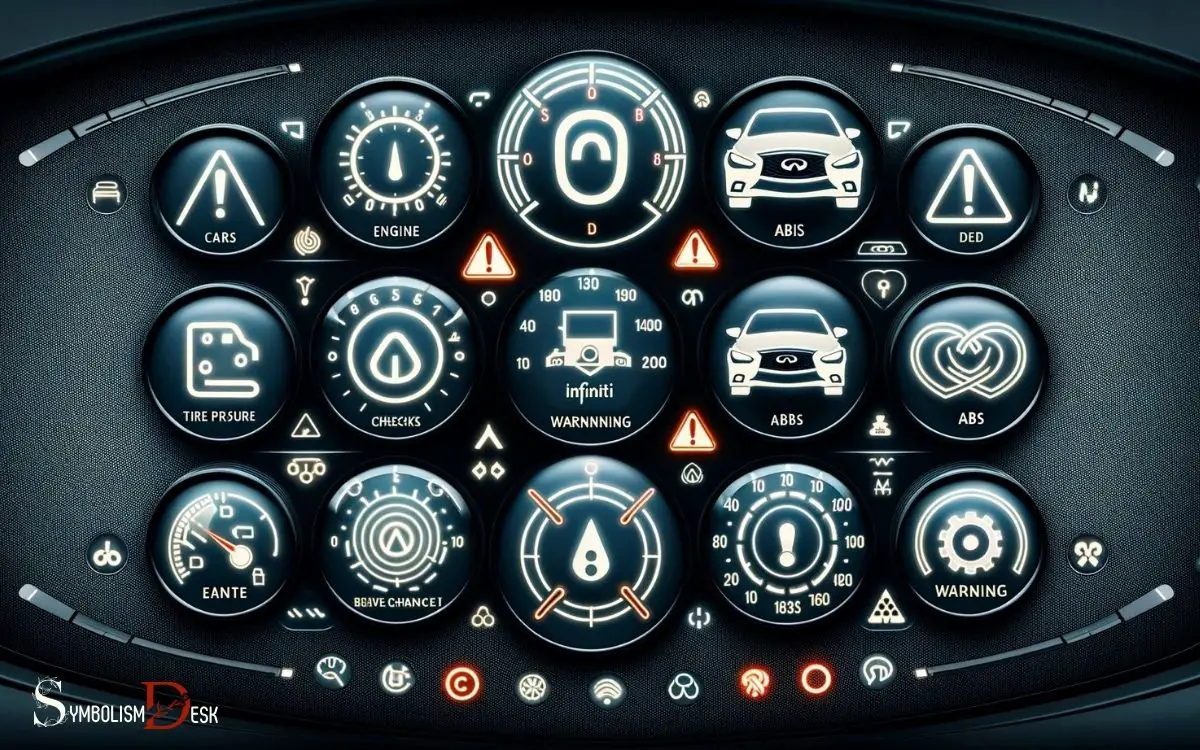
Key Takeaway
Understanding Dashboard Indicator Lights
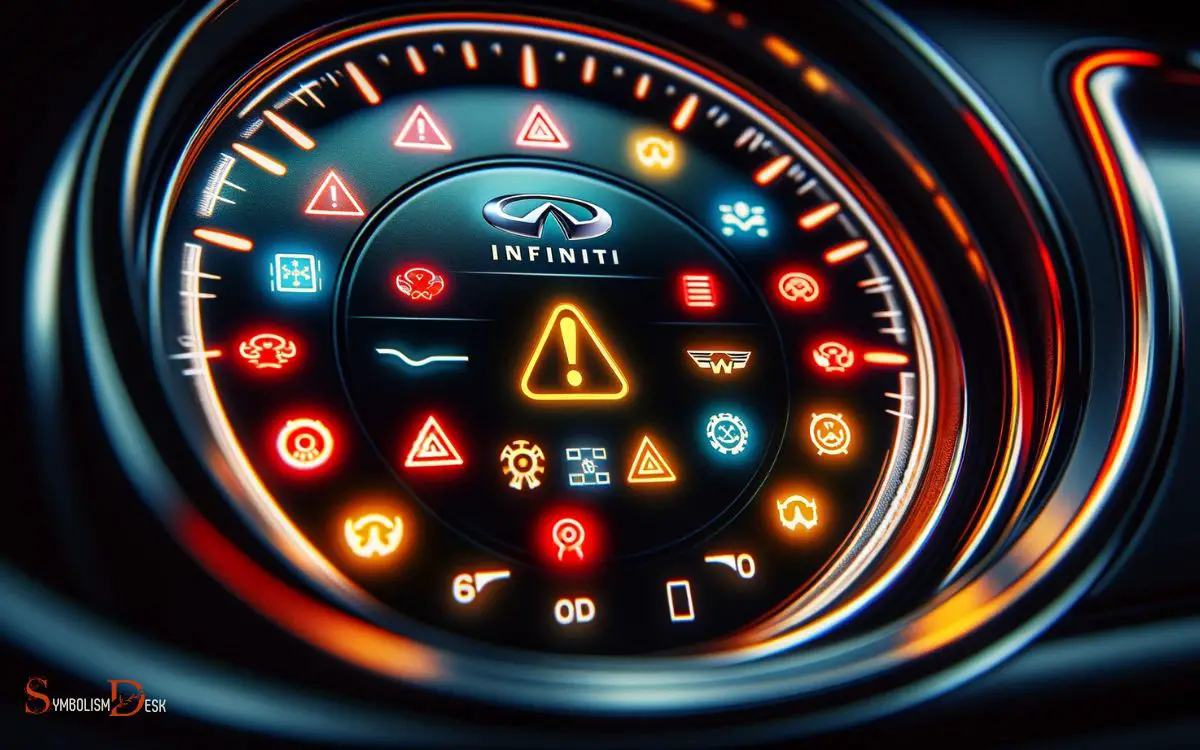
Dashboard indicator lights in an Infiniti vehicle provide vital information about the car’s status and potential issues.
These lights serve as an early warning system, alerting the driver to various conditions such as low fuel, overheating, or a malfunction in the vehicle’s systems. Understanding these dashboard indicator lights is crucial for maintaining the vehicle’s health and safety.
The lights are color-coded, with green typically indicating that a system is operating, yellow signaling a potential issue that requires attention, and red indicating a serious problem that needs immediate action.
Familiarizing oneself with the meaning of each symbol and taking appropriate action when they illuminate can prevent costly repairs and ensure a safe driving experience.
Engine and Transmission Warning Lights
The engine and transmission warning lights on the Infiniti dashboard are crucial indicators of potential issues with the vehicle’s powertrain.
The engine overheating warning light alerts the driver to a potential overheating problem, prompting immediate action to prevent damage to the engine.
The transmission fluid level and check engine lights are also important indicators that require attention to ensure the proper functioning of the vehicle.
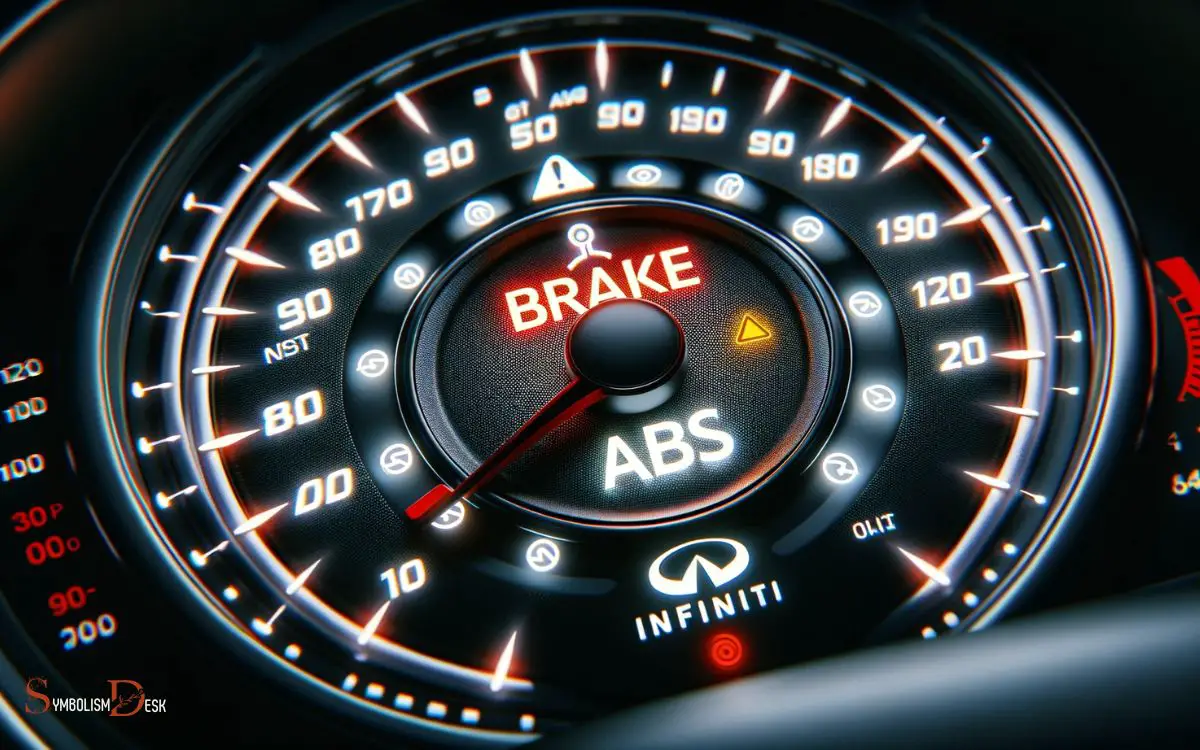
Engine Overheating Warning
When an Infiniti’s engine and transmission warning lights illuminate simultaneously, it indicates a serious issue with the vehicle’s temperature regulation system. This often points to engine overheating, which requires immediate attention to prevent severe damage.
Here are the potential causes for this warning:
- Low Coolant Level: A low coolant level can lead to insufficient heat dissipation, causing the engine to overheat.
- Faulty Thermostat: A malfunctioning thermostat may disrupt the engine’s cooling system, leading to overheating.
- Cooling System Leaks: Leaks in the cooling system can result in a loss of coolant, leading to overheating.
- Malfunctioning Water Pump: A faulty water pump can impede coolant circulation, causing the engine to overheat.
If the engine and transmission warning lights illuminate, it’s crucial to pull over safely and address the issue promptly to prevent costly damage.
Transmission Fluid Level
In an Infiniti, the transmission fluid level should be checked if the engine and transmission warning lights illuminate simultaneously, indicating a potential issue with the vehicle’s temperature regulation system.
| Transmission Fluid Level | Action Required |
|---|---|
| Low | Check for leaks and top up fluid as per manufacturer’s specifications. |
| Normal | Have the vehicle’s temperature regulation system inspected by a certified mechanic. |
| Excessive | Drain excess fluid to avoid potential damage to the transmission system. |
When the transmission fluid level is low, it can lead to overheating and increased friction within the transmission system.
Check Engine Light
If both the engine and transmission warning lights illuminate simultaneously in an Infiniti, it indicates a potential issue with the vehicle’s temperature regulation system.
This could be due to a variety of reasons, including low coolant levels, a malfunctioning thermostat, or a problem with the cooling fan.
When facing this situation, it is crucial to address it promptly to prevent potential damage to the engine or transmission.
To troubleshoot this issue, one should follow these steps:
- Check the coolant level and top it up if it’s low.
- Inspect the thermostat for any signs of malfunction and replace if necessary.
- Ensure that the cooling fan is functioning properly.
- If the problem persists, seek professional assistance for a comprehensive diagnosis and repair.
Ensuring the proper functioning of the temperature regulation system is essential for the overall health of the vehicle.
Brake System and ABS Warning Lights
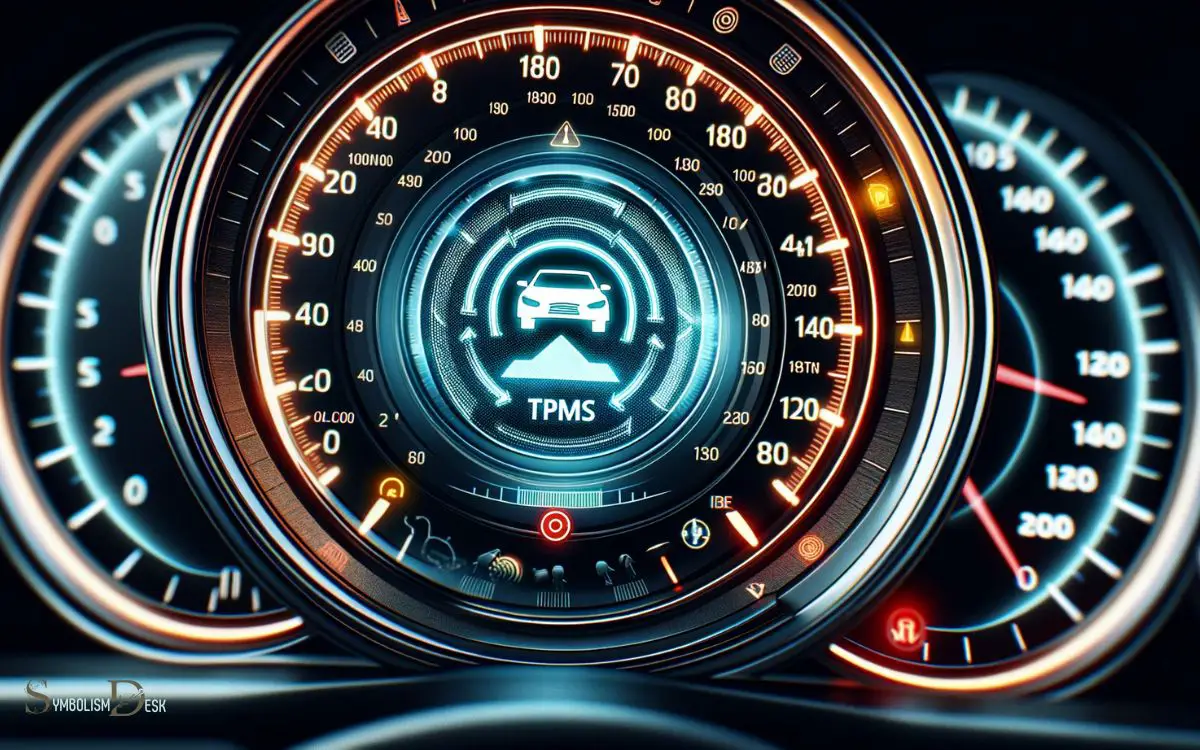
Illuminated with a red or yellow light, the brake system and ABS warning lights indicate potential issues with the braking system in Infiniti vehicles.
The red brake system warning light typically signifies problems such as low brake fluid level, a malfunction in the braking system, or the parking brake being engaged. If the light comes on while driving, it is advisable to pull over safely and check the brake fluid level.
The yellow ABS warning light indicates a fault in the anti-lock braking system. This could be due to issues with the ABS sensors, the ABS module, or a loss of communication between the various components.
When either of these warning lights illuminates, it is crucial to have the braking system inspected by a qualified technician to ensure safe operation of the vehicle.
Tire Pressure Monitoring System (TPMS) Light
The TPMS light on an Infiniti dashboard indicates low tire pressure and prompts the driver to check the tire pressure.
This warning system is designed to alert the driver when one or more tires are significantly underinflated, which can compromise vehicle safety and performance.
Monitoring tire pressure is crucial for maintaining optimal driving conditions and preventing potential tire damage.

TPMS Indicates Low Pressure
The TPMS light illuminates to indicate low pressure in the tires on the Infiniti dashboard. When this light turns on, it is essential to take immediate action to avoid potential safety hazards and damage to the tires.
Here is what to do:
- Check Tire Pressure: Use a tire pressure gauge to measure the pressure in each tire, including the spare.
- Inflate Tires: If the pressure is below the recommended level, inflate the tires to the specified pressure indicated in the owner’s manual or on the driver’s door jamb.
- Inspect for Damage: Look for any visible signs of tire damage, such as punctures or cuts, which may be causing the low pressure.
- Reset TPMS: After addressing the low tire pressure, reset the TPMS system as per the vehicle’s instructions.
Check Tire Pressure
When the TPMS light illuminates on the Infiniti dashboard, indicating low tire pressure, drivers should promptly check the tire pressure using a gauge. This warning light typically resembles an exclamation point inside a tire, and it serves as a reminder to inspect tire pressure.
To properly check the tire pressure, it’s important to ensure that the tires are cold, as driving can increase tire pressure and lead to inaccurate readings.
The recommended tire pressure for Infiniti vehicles can usually be found on a sticker inside the driver’s side door jamb or in the owner’s manual.
In the event of low tire pressure, drivers should add air to the affected tire(s) to reach the recommended pressure levels and ensure optimal vehicle performance and safety.
Oil Pressure and Engine Temperature Warning Lights
Drivers should pay attention to the oil pressure and engine temperature warning lights on the Infiniti dashboard. These warning lights indicate critical issues that, if ignored, can lead to severe damage to the vehicle’s engine.
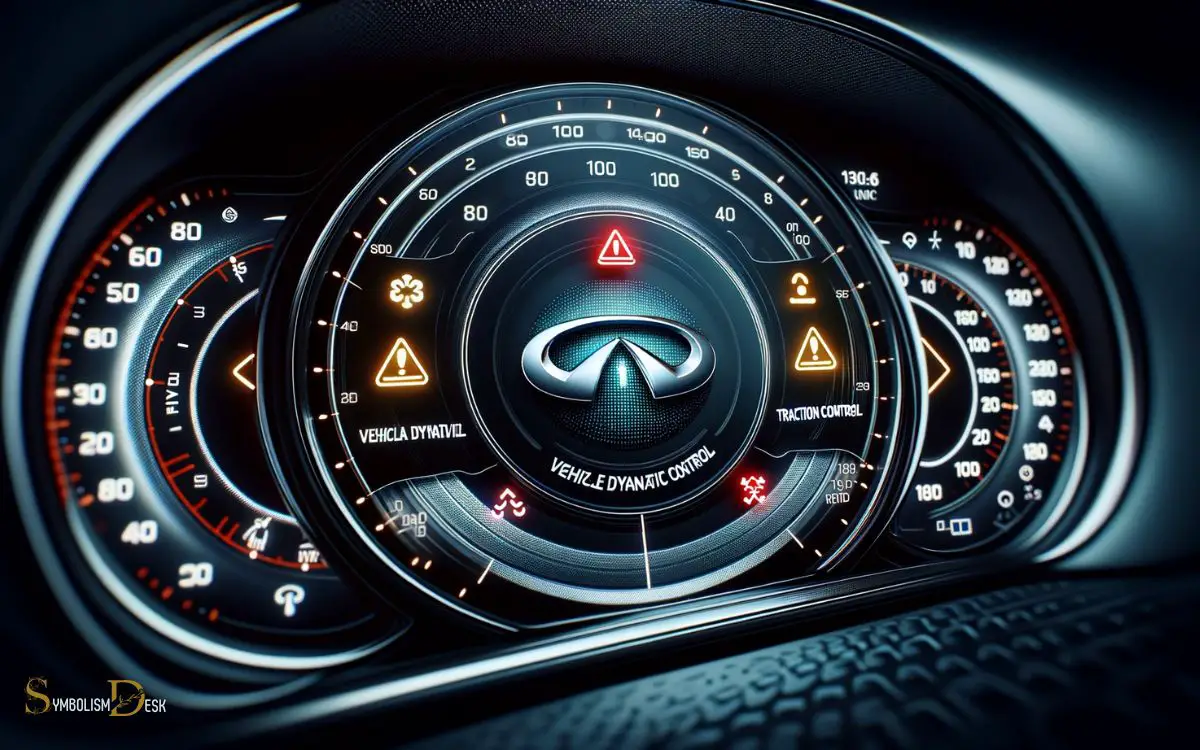
Here are the crucial points to consider:
- Oil Pressure Warning Light: This light illuminates when the oil pressure in the engine falls below a safe level. It signifies potential engine damage due to insufficient lubrication.
- Engine Temperature Warning Light: When this light comes on, it indicates that the engine is overheating. Continuing to drive with this light on can result in significant engine damage.
- Immediate Action: If either of these warning lights illuminates, the driver should pull over safely, turn off the engine, and check the oil level and engine coolant immediately.
- Professional Assistance: If the warning lights persist after taking initial action, seek professional assistance to prevent severe engine damage.
Vehicle Dynamic Control (VDC) and Traction Control System (TCS) Lights
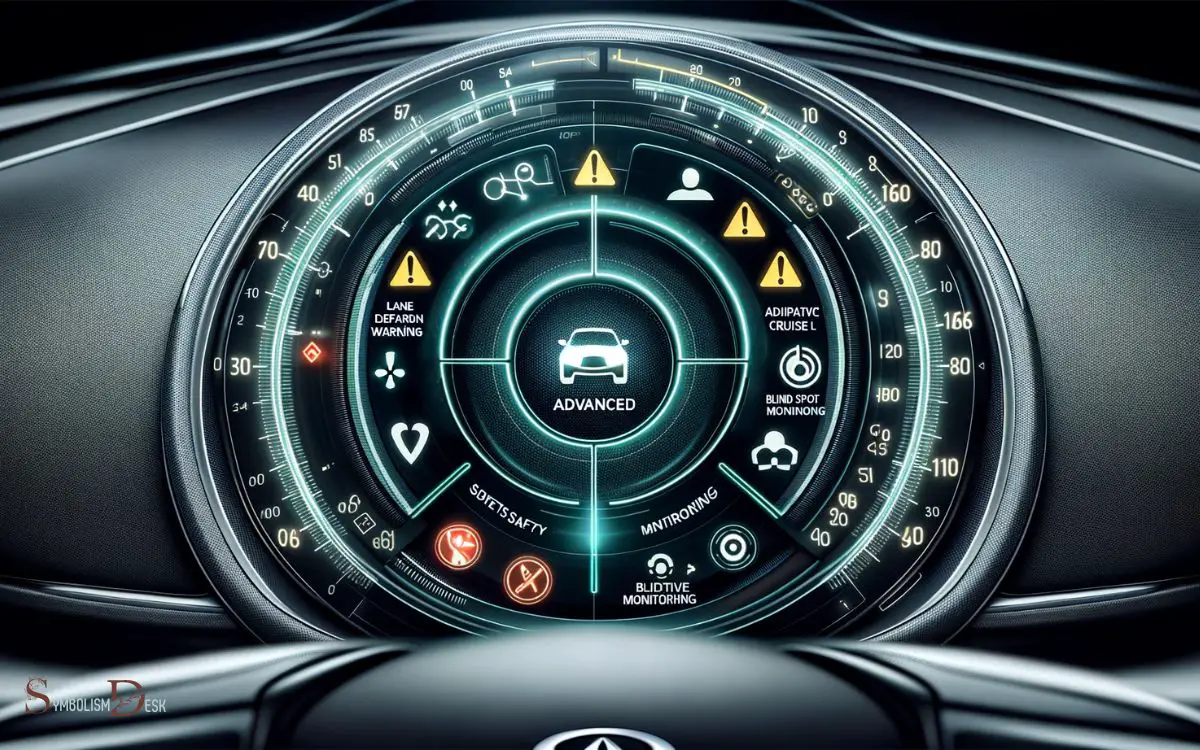
If an Infiniti vehicle experiences issues with its Vehicle Dynamic Control (VDC) and Traction Control System (TCS) lights, it may indicate potential stability and traction problems.
The VDC helps maintain stability and control during cornering or evasive maneuvers by reducing engine output and applying brake pressure to specific wheels.
The TCS, on the other hand, helps prevent the drive wheels from losing traction during acceleration by controlling engine output.
When these lights illuminate, it signifies a malfunction in these systems, which can compromise the vehicle’s stability and traction.
It is crucial to have the vehicle inspected by a qualified technician to diagnose and address any underlying issues promptly.
| Warning Light | Indication |
|---|---|
| VDC Off | VDC system is turned off |
| TCS | Traction Control System is malfunctioning |
| VDC/TCS | Both systems are malfunctioning, indicating potential stability and traction issues |
Advanced Safety Features and Other Indicators
The dashboard in Infiniti vehicles features an array of advanced safety indicators, providing drivers with vital information regarding the vehicle’s various safety systems.

These indicators include:
- Forward Collision Warning: This system alerts the driver when it detects an imminent collision with the vehicle in front.
- Blind Spot Warning: It notifies the driver of vehicles in the blind spot area, enhancing awareness during lane changes.
- Lane Departure Warning and Prevention: This system alerts the driver when the vehicle drifts out of its lane and can even apply subtle braking to bring the vehicle back into the lane.
- Intelligent Cruise Control: This feature maintains a set distance from the vehicle in front, automatically adjusting the speed to ensure a safe following distance.
These advanced safety features contribute to a safer driving experience for Infiniti vehicle owners.
Conclusion
Understanding the dashboard warning lights on your Infiniti car is crucial for maintaining safe and efficient driving. Did you know that 40% of car owners can’t identify the meaning of dashboard warning lights? It’s important to familiarize yourself with the different dashboard warning lights on your Infiniti car, including the cyclone warning light meaning. Knowing how to properly respond to these warnings can prevent potential issues and ensure the ongoing performance of your vehicle. Take the time to review your car’s manual and educate yourself on the various warning lights so you can address any concerns promptly and keep your Infiniti in top condition.
By familiarizing yourself with these indicators, you can address potential issues promptly and prevent costly repairs. Stay informed and stay safe on the road.






